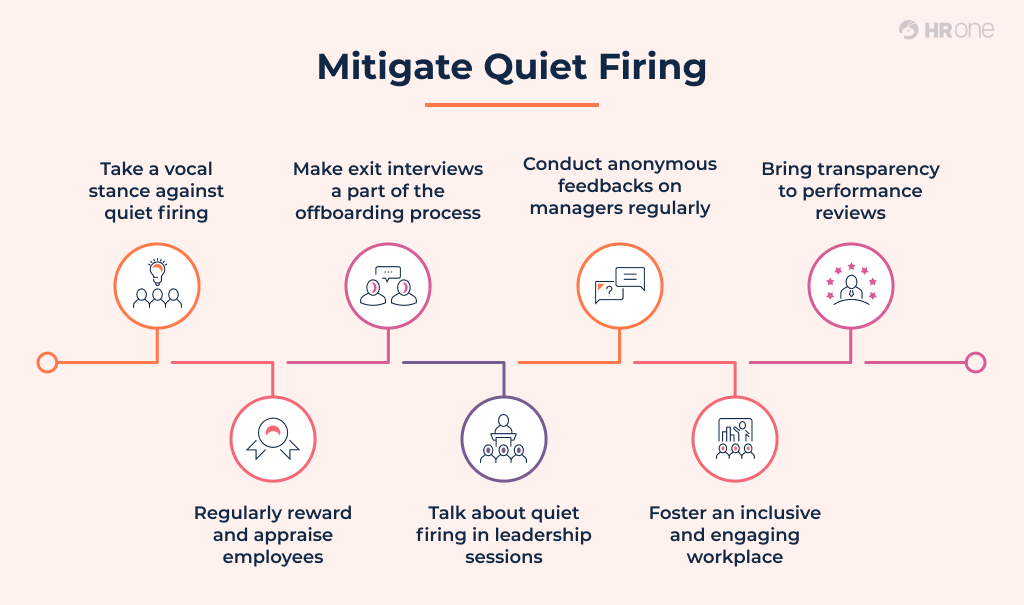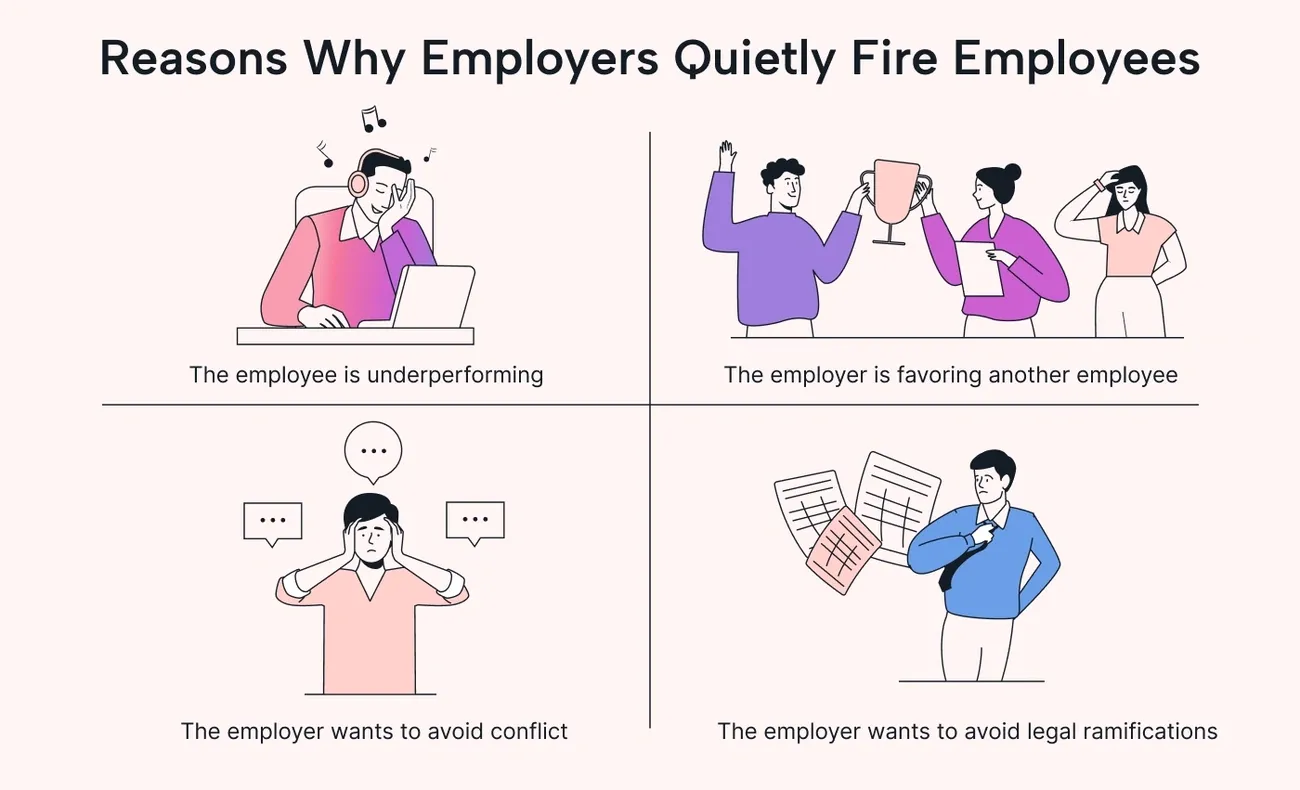Your employer might be subtly pushing you toward the exit door. You’re not alone in this situation. Quiet firing happens everywhere around us. A 2025 HRTech survey of over 1,000 U.S. managers revealed that 53% of employers use these passive-aggressive tactics.
Companies don’t formally terminate employees. They create uncomfortable working conditions that make people quit on their own. This workplace bullying tactic has become common. A 2022 LinkedIn survey of 20,000 people showed that all but one of these people had either seen or experienced it firsthand. Quiet firing signs can be hard to spot when they first appear.
My experience in HR consulting shows many cases where employees realized the situation too late. Quiet firing can destroy workplace trust and hurt employee retention by a lot if left unchecked. This piece reveals the seven most common signs of quiet firing at work and gives you the practical strategies to protect your career and fight back.
Being Left Out of Communication Channels

Image Source: Paychex
Communication exclusion stands out as the most insidious form of quiet firing. Managers who want someone gone without actually firing them often start by cutting them off from information flows. My experience shows this pattern clearly.
Being left out of communication as a quiet firing sign
Your sudden exclusion from email threads, group chats, or important meetings that affect your work raises a major red flag. A shocking 96% of people surveyed reported workplace bullying through exclusion. This calculated strategy aims to isolate you professionally.
Why exclusion from emails and chats matters
Getting cut off from communication channels goes beyond mere inconvenience—studies show exclusion triggers the same brain region that processes physical pain. This isolation affects your ability to perform your job well. You’ll likely make mistakes without access to critical information, which further “justifies” your marginalization.
Examples of quiet firing through communication gaps
These communication exclusion tactics happen often:
- Getting left off important email threads
- Missing invites to meetings you used to attend
- Getting information late or not at all
- Colleagues who go quiet when you join conversations
How to deal with quiet firing via communication exclusion
The best approach isn’t to quit right away. You might think about finding allies in other parts of the organization. One employee who faced isolation found success by connecting with “people elsewhere, basically a pocket where my ideas and input was welcome”. Keeping records of each exclusion instance builds evidence if you need to escalate things later.
Performance Improvement Plans (PIPs) as a Weapon

Image Source: Amazing Workplaces
Performance Improvement Plans might look supportive on paper, but they’ve become sophisticated quiet firing tools in reality.
What is a PIP and how it’s used in quiet firing
A PIP serves as a well-laid-out document that highlights your supposed performance shortfalls and provides an action plan to improve. These plans should help struggling employees, but they’ve become management’s quickest way to push unwanted staff out. A management academic puts it clearly: “If you get that PIP, you’ve been quiet fired, probably three to six months ahead of time”.
Why PIPs are often a setup for failure
PIPs turn into failure tools through unrealistic goals and lack of support. HR professionals acknowledge that termination becomes the expected outcome for 80% of employees on PIPs. A workplace law expert states it plainly: “In my experience, it is very rare for someone failing to live up to performance measures to succeed in a PIP”.
Examples of quiet firing through PIPs
To name just one example, see Arjun’s case – a tech manager with six years of excellent performance who got a PIP after new management took over. He shares: “Every time I met one goal, another would be added, or the criteria for success would change”. Another case shows an administrative assistant with 17 years of service suddenly facing a PIP without warning.
How to deal with quiet firing via PIPs
You can curb an unfair PIP by:
- Documenting everything, including positive feedback and PIP-related communications
- Writing formal objections
- Addressing each performance criticism specifically
- Collecting evidence of structural issues beyond your control
- Getting legal advice, especially when discrimination or retaliation might be involved
Unreasonable or Repetitive Work Assignments

Image Source: HROne
Managers use work assignments as a calculated quiet firing strategy. Task manipulation creates a no-win situation that pushes employees toward the exit door without formal termination.
Repetitive tasks as a quiet firing tactic
Challenging assignments slowly turn into repetitive, low-value tasks. These tasks neither build skills nor improve outcomes. Job stagnation wears down employee participation over time. Managers might give the most unpleasant tasks to specific employees. They hope these employees will quit out of frustration.
Why meaningless work is demoralizing
Pointless work damages employee psychology. Research shows employees who do meaningless tasks feel unsatisfied, frustrated, and lack purpose. This creates a vicious cycle. Workers take meaningless jobs for paychecks but stay deeply unhappy. Doing nothing substantial throughout your workday leads to disconnection.
Examples of quiet firing through task repetition
Common tactics include:
- Giving boring administrative tasks to skilled professionals
- Taking away enjoyable responsibilities without explanation
- Overloading with impossible deadlines
- Cutting workload to create boredom
- Giving time-sensitive tasks at day’s end
How to deal with quiet firing via task overload
Start by documenting all unreasonable assignments. Stay calm and objective when you discuss workload concerns. Use evidence from your analysis to explain why unreasonable requests don’t work. Look at your job description to show when tasks fall outside your role. You retain control by keeping professional relationships throughout this process.
Sudden Changes in Work Conditions or Benefits

Image Source: Motion
Companies now use workplace benefit manipulation as a quiet way to fire employees. Policy changes behind the scenes often reveal an employer’s strategy to make people quit on their own.
Changes in benefits as a quiet firing sign
Companies reduce benefits more often now as a way to push employees out without formal terminations. A worrying 53% of companies either use or plan to use quiet firing tactics, which include benefit cuts and mandatory office time requirements. Companies change retirement contributions, health insurance coverage, and professional development opportunities without explaining why.
Why altering job perks can push employees out
Research shows employees quit mainly because of low pay, limited growth, and disrespect. Companies create unfriendly work environments by changing benefits to avoid paying severance and legal consequences. Return-to-office rules have become another quiet firing tool, with 25% of VP and C-suite executives admitting they wanted people to quit during RTO rollouts.
Examples of quiet firing through benefit cuts
Companies often cut benefits by:
- Reducing retirement plan matches
- Removing stipends and wellness programs
- Limiting flexible work options
- Stopping professional development funds
- Lowering bonuses or incentives
How to deal with quiet firing via policy changes
You can curb benefit-related quiet firing by documenting changes and comparing them with your original employment agreement. Ask for written explanations to create a record. Stay professional and learn if these changes affect specific employee groups unfairly, which might point to discrimination. Take time to assess if your new benefits package meets your needs or if you should look for better opportunities elsewhere.
Lack of Feedback or Recognition

Recognition starvation stands out as one of the most obvious yet overlooked signs of quiet firing. Feedback withdrawal works through calculated silence that gradually destroys confidence and performance.
No feedback as a quiet firing indicator
Managers rarely withhold feedback and recognition by accident. Research shows one in three workers strongly agree they received recognition for good work in the last week. Managers who practice quiet firing tend to skip one-on-one meetings and performance reviews. They stop giving positive recognition completely. The numbers tell an interesting story – while 93% of employees at top organizations support non-cash rewards, only three in ten got such recognition during their workweek.
Why silence from managers is harmful
Lack of feedback creates lasting damage in the workplace. Employees who don’t receive adequate recognition become twice as likely to leave their jobs within a year. Teams starved of recognition show lower commitment, motivation, and cognitive dissonance. Data proves this point – teams that receive regular recognition show 14% higher commitment and efficiency.
Examples of quiet firing through feedback withdrawal
Managers typically hold back feedback by:
- Giving unclear instructions or keeping vital information
- Answering “you’re doing fine” when asked about improvements
- Taking unusually long to respond to messages
- Becoming extremely critical without any real reason
How to deal with quiet firing via lack of recognition
You can curb recognition starvation by carefully tracking your achievements. Start regular discussions about career growth with your manager. Look for feedback from coworkers or other departments if your supervisor stays quiet. A direct conversation about the issue might help – 85% of employees simply want to hear “thank you” in their daily interactions.
Isolation from Team and Culture
Social disconnection works as a powerful yet often overlooked quiet firing strategy. Managers cut employees from their organization’s social fabric as a calculated exit technique.
Workplace isolation as a quiet firing sign
Managers isolate employees from team activities, meetings, and decision-making processes to signal quiet firing. Employees experience workplace isolation when they lack proper friendships or social networks at work. 38% of employees feel lonely on the job. This isolation hits younger workers harder—about 75% of millennial and Gen Z workers feel lonely and cut off at work.
Why being left out of team culture matters
The brain processes exclusion similar to physical pain. Isolated employees show lower productivity, higher turnover, increased absenteeism, and presenteeism. Workers with high workplace belonging show a 56% increase in job performance and take 75% fewer sick days. Workplace exclusion takes a toll on mental health. It starts with irritation and can lead to self-isolation.
Examples of quiet firing through social exclusion
Common isolation tactics include:
- Moving employees away from their colleagues to separate work areas
- Leaving targets out of social events and team-building activities
- Getting coworkers to distance themselves from the targeted employee
- Giving solo work while others work in teams
- Setting up isolated shifts with minimal team interaction
How to deal with quiet firing via isolation
Document each time you’re left out. Build connections elsewhere through special interest workgroups. Your mental health needs attention when workplace isolation hits, so focus on self-care throughout this experience. In spite of that, know when a toxic environment becomes too much—leaving might be your healthiest option.
Micromanagement or Total Neglect

Image Source: Qandle
The most psychologically damaging quiet firing approach comes from managers who use control as a weapon. They either suffocate with oversight or abandon their team completely. This management style creates an impossible work environment.
Extreme oversight or neglect as quiet firing
Micromanagers hover over their employees’ shoulders and scrutinize every detail until workdays become unbearable. The opposite happens when managers completely check out, leaving staff with no supervision, support, or feedback. Both extremes serve one purpose – they push unwanted staff to resign.
Why inconsistent management is a red flag
Unpredictable management styles wreak havoc in the workplace. Research shows negative workplace interactions affect employees three times more strongly than positive ones. Employees lose confidence despite their previous competence due to this inconsistency. The data shows 71% of employees say micromanagement hurts their performance.
Examples of quiet firing through micromanagement
Managers use these quiet firing tactics:
- They scrutinize minor details excessively
- They add unnecessary steps to procedures
- They keep changing instructions
- They demand excessive documentation
How to deal with quiet firing via poor leadership
Keep records of all interactions with inconsistent managers. Schedule a professional conversation based on this documentation to address specific behaviors rather than personalities. Since 70% of employees think about leaving due to micromanagement, finding a workplace that values your contributions might be your best option.
Comparison Table
| Sign of Quiet Firing | Key Statistics | Main Indicators | Impact on Employees | Recommended Response Strategies |
|---|---|---|---|---|
| Being Left Out of Communication | 96% of people report workplace bullying through exclusion | – Left out of email threads – Not invited to meetings – Late or missing information |
– Triggers same brain region as physical pain – Poor work performance – Makes more mistakes |
– Build connections elsewhere in company – Keep records of exclusion – Create alternate communication channels |
| Performance Improvement Plans (PIPs) | 80% of employees on PIPs lose their jobs | – Goals that can’t be met – No support provided – Moving success goalposts |
– Job uncertainty – Higher stress levels – Damaged professional image |
– Keep detailed records – Challenge issues in writing – Respond to each criticism – Talk to a lawyer |
| Unreasonable Work Tasks | Not specified | – Mundane paperwork – Fun tasks taken away – Unachievable deadlines – Much less work than usual |
– Job dissatisfaction – Growing frustration – No sense of purpose – Lost interest in work |
– Track unfair assignments – Check job description – Talk about workload concerns |
| Changes in Work Conditions | 53% of companies use or plan quiet firing tactics | – Fewer benefits – Lower retirement funds – No more stipends – Less flexible hours |
– Loss of respect – Money problems – Unhappy at work |
– Record all changes – Ask for written reasons – Review employment contract |
| Lack of Feedback | Only 1 in 3 workers get praise for good work | – No one-on-one meetings – Missing reviews – Unclear directions – Slow responses |
– Twice as likely to leave – Less loyal to company – Lower drive to work |
– Track achievements – Start growth discussions – Ask peers for input |
| Isolation from Team | 38% of workers feel lonely; 75% of millennials/Gen Z affected | – Working apart from others – Left out of team events – Working alone – Minimal team contact |
– Gets less done – More sick days – Mental health suffers |
– Note when left out – Join work groups – Take care of yourself |
| Micromanagement/Neglect | 71% say micromanagement hurts their work | – Too much oversight – Extra red tape – Mixed messages – Total hands-off approach |
– Feels powerless – Lost self-trust – Work quality drops |
– Log all interactions – Discuss issues calmly – Look for new jobs |
Conclusion
Quiet firing has become a tough reality for many professionals today. In this piece, we got into seven clear signs that your employer might be pushing you out through passive-aggressive tactics rather than direct termination. So, spotting these patterns early gives you the most important advantage to protect your career and mental wellbeing.
You need courage and strategy to fight back against quiet firing. Documentation serves as your strongest defense and creates an evidence trail if you need to escalate the situation. On top of that, you retain control by staying professional during this tough period. This shows your character and keeps relationships intact for your future.
Your instincts matter most when workplace dynamics suddenly change. People who face quiet firing often sense problems before they can point to specific tactics. Your feelings of isolation or frustration often point to real issues rather than paranoia.
Being sidelined at work drains you emotionally and becomes hard to handle alone. A trusted partner can make all the difference. If you’re in this situation and need a clear strategy to reclaim your position or plan a powerful exit, I invite you to book a one-on-one strategy call with me. We can build your action plan together.
Note that quiet firing shows management failure, not your personal shortcomings. These tactics try to shake your confidence, but your skills and contributions have real value. You deserve a workplace that appreciates your talents rather than pushing you toward the exit, whether you fight back or seek better opportunities elsewhere.
Key Takeaways
Quiet firing affects millions of workers through subtle manipulation tactics designed to force voluntary resignations. Here are the essential insights to protect your career:
• Document everything immediately – Create evidence trails of exclusion, unreasonable assignments, and policy changes to build your defense case.
• Recognize the seven warning signs – Communication exclusion, weaponized PIPs, meaningless tasks, benefit cuts, feedback withdrawal, isolation, and extreme management styles.
• 53% of employers admit using quiet firing tactics – This workplace bullying strategy has become mainstream, making awareness crucial for career protection.
• Fight back strategically, not emotionally – Address behaviors professionally, seek allies within the organization, and maintain documentation while exploring options.
• Trust your instincts when workplace dynamics shift – Feelings of isolation or sudden treatment changes often signal legitimate concerns, not paranoia.
The key to surviving quiet firing lies in early recognition and strategic response. Whether you choose to fight back within your current role or seek healthier opportunities elsewhere, remember that these tactics reflect management failure, not your professional worth. Your skills have genuine value—don’t let manipulative practices undermine your confidence or career trajectory.




